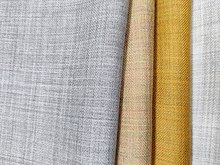Piece goods were the textile materials sold in cut pieces as per the buyer's specification. The piece goods were either cut from a fabric roll or produced with a certain length, also called yard goods. Various textiles such as cotton, wool, silk, etc., were traded in terms of piece goods. The prices were determined as per the fabric quality.[1][2][3][4][5]

John Forbes Watson classified Indian textiles into two types: piece goods and loom goods. Piece goods are materials that must be cut and sewn before they can be used, whereas loom goods, such as scarves and Saris, are ready to use after leaving the loom.[6]
Many Indian clothes were ready to wear after leaving the loom. These were simple pieces of cloth of dimensions suited to the purposes. Lungi, Dhoti, and Sari are few specific examples of drape clothes. Other cloths produced according to specified dimensions are:
Textile piece goods have been sold globally in many varieties, including grey, bleached, or dyed and prints.[22][23] And the practice is still being followed by many buyers. The knitted fabric is traded by weight also.
Historically drapers and cloth merchants were trading in piece goods. India was famous for its handloom cotton piece goods. Many fabrics of coarse to fine cotton qualities such as Baftas, calicos, and muslins were used to be exported during the Mughal era.
There are records stating that in 1664 the East India Company imported 273,746 pieces of cotton cloth from India (approximately 4.2 million sq. meters). This increasing trend finally peaked in 1684 at 1,760,315 pieces (or 26.9 million sq. meters).[24][25] Woolen and silk piece goods were also traded.[26][27][3][28][29] Woollen piece goods for example shawls were exported from Kashmir.[30]
The exports were continued until the British cloths emerged in the 19th century.[31] Substantial quantities of various piece goods were exported from Madras in 18th and 19th century. Punjum cloths accounted for a sizable portion of Madras' exports in the 18th century. Punjum, Salampores, Palampores, Chintz, Book muslin and Longcloth, varieties of Ghingahm were among the piece goods which were exported to America from Madras.[32]: 22, 429 [20]
During the 1920s, the Philippines was the largest market for cotton piece goods exported by the United States of America.[33]
Several textile piece goods are still traded with different HS codes to differentiate the weave, structure, and composition. For example, HS code 51123030 stands for hundred percent wool, and 58109100 is for woven dyed cotton with embroidery piece goods. The Harmonized System, or HS, is an identification code developed by the World Customs Organization (WCO).[34][35]